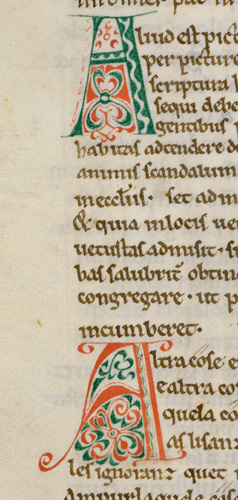Image
© Hildesheim, St Godehard |
CHANSON ENDS,
LETTER OF POPE GREGORY THE GREAT
The Chanson concludes at the top of the page, with its normal pattern
of alternating blue and red capitals. The line spacing is regular, as
it was on the previous pages.
The letter of Pope Gregory, first in Latin and then in French is prefaced
by initials in red and green, decorated with curling arabesques. The spacing
of the lines becomes crabbed and agitated. In the Latin text, five lines
fit into the height of the initial A whereas in the French version there
are four more spacious lines. Compressing the lines was unnecessary as
there is surplus space at the bottom of the page. This spacing gives the
passages a sense of spontaneous urgency: having completed the Chanson,
the writer was not sure if he could fit in all this pièce justicative
twice, to make sure the reader understood it.
Haney detects a change of scribe for the Gregory text (1995,2) (see SCRIBES)
but the layout appears more discordant than the lettering itself. These
passages appear be written by the same man, Scribe 3, but at a different
time (Michael Gullick, pers. comm.)
The green and red arabesque initials are not found elsewhere in the book.
They are quite close to other arabesque letters from the St Albans scriptorium,
found in B.L. Royal 12 G xiv, f38vB; Stoneyhurst College 7, f3a; Cambridge,
Pembroke College MS 82, ff124v and 130v; and possibly B.L. Royal 2 B iv,
f184 (Thomson, 1982, 161,162,142, 143, 147). Apart from the Pembroke Bede,
these are all attributed to the mid twelfth century, giving further support
to the observation that the Gregorian passages may be added slightly later
than the preceding text.
Quire 5

Image
© Hildesheim, St Godehard
|
![]()